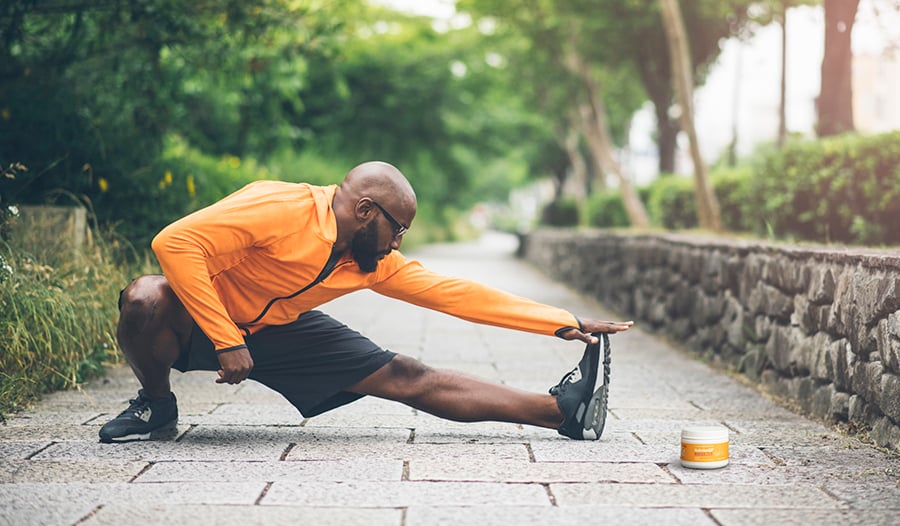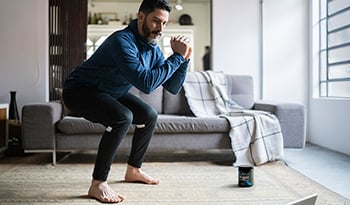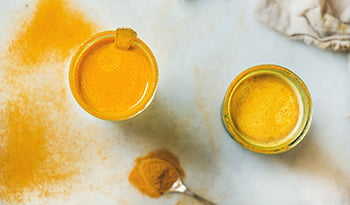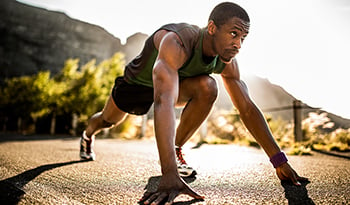How to Properly Hydrate for Optimal Athletic Performance
DISCLAIMER:This blog does not intend to provide diagnosis...
- In this article:
- The Importance of Fluid Balance
- Plan for Optimal Hydration
- Fuel Your Workout
- Monitor Your Sweat Loss
- Calculate Your Personal Fluid Needs
- Electrolytes Are Essential
- Replenish Your Glycogen Stores
- Avoid Heat-Related Illness
- Post-Workout Hydration and Fuel
- Know the Signs of Hypohydration
- Best Drinks and Snacks for Post-workout Recovery
- Homemade Sports Drink Recipe
- Easy Post-Workout Snacks
- Hydrate for Optimal Performance

We all know water is important, but have you ever wondered why? Getting enough water throughout the day helps regulate your body temperature, keeps your eyes, nose, and mouth moist, helps protect your organs, and carries nutrients and oxygen to your cells, along with many other functions. Without water and proper hydration, many of these functions cannot occur.1
In this article, we will explore the importance of proper hydration for athletic performance, how to know how much you need, signs you may not be getting enough, and practical tips for optimizing your hydration status.
The Importance of Fluid Balance
Water is approximately 50 to 70% of the human body by weight. When we exercise and begin to sweat, this fluid balance can shift.2
Sweating is critical for cooling your body and keeping your core temperature stable.2,3 But if you don’t drink enough fluid before and during intense workouts, you may be unable to replenish the fluid you lose through sweat quickly enough. This can lead to hypohydration, which is the process of losing body water.
During exercise, hypohydration can be dangerous because it causes a decrease in blood volume and blood flow to the skin.3,4 Continuing to exercise in a state of hypohydration also negatively impacts how you think and perform.2,4
Plan for Optimal Hydration
To avoid hypohydration, it is important to hydrate before, during, and after exercise. Let’s talk through a plan for optimal hydration.
Remember that these recommendations should be used as guidelines, as many other variables can affect hydration status, including sweat rate, water intake, heat, intensity, duration, and exercise type.5
It is important to begin exercise well-hydrated. If you begin exercise when you are hypohydrated, you may have decreased blood flow, which can impair sweating. When your body cannot sweat, you are at an increased risk of heat-related illness because your body cannot cool itself.5
Aim to drink about 5 to 7 milliliters of water per kilogram of body weight within the four hours before you exercise. For a 150-pound person, this would equal almost 2 cups of water. If your urine is dark in color or if your body isn’t producing urine, consume an additional 3 to 5 milliliters of water per kilogram of body weight two hours before exercising.3
Fuel Your Workout
In addition to proper hydration, it is also important to fuel correctly. Eating 1 to 4 grams of carbohydrates per kilogram of body weight in the 1 to 4 hours before you exercise is an excellent goal to ensure you have enough energy for your workout.
Carbohydrates are your body’s primary fuel source for muscle contraction, so it’s important to ensure your body’s glycogen stores (aka carbohydrate stores) are full.6 A peanut butter and jelly sandwich, granola, energy bars, or some fruit are a few quick and easy pre-workout snacks to have on hand.
Monitor Your Sweat Loss
When we engage in challenging, high-intensity workouts, our bodies may sweat a lot—especially during the hot summer months. It’s important to monitor your sweat and ensure you are replenishing lost fluids through proper hydration.
Aim to avoid losing more than 2% of your body weight in sweat.3,5 When you lose more than 2% of your body weight in sweat, your physical and cognitive performance in aerobic activities like running, biking, and hiking will suffer.5 When you are engaged in anaerobic activities, such as weight lifting, losing more than 3 to 4% of your body weight in sweat decreases your strength and power.5
Calculate Your Personal Fluid Needs
We all have different bodies, and some sweat more than others. Your recommended fluid intake varies based on how much you sweat. Many factors affect how much you sweat or your sweat rate. The rate of sweat loss is directly related to exercise intensity—the more intensely you exercise, the more you sweat.
Use this equation to calculate your personal sweat rate:6
[weight loss (kilograms) + fluid intake (liters)]/exercise time (hours) = sweat rate (liters/hour)
Once you know your sweat rate, you’ll know how much fluid you should drink per hour to replace fluid lost through sweat.
Engaging in intermittent and endurance sports for long periods can result in heavy sweat loss. Body mass, hot or humid environments, sports type, and clothing or equipment can also affect your sweat rate.4
Don’t wait until you’re thirsty to drink fluids—your thirst response can be delayed while exercising, and relying on thirst may lead to hypohydration.5
Electrolytes Are Essential
Sweat isn’t just made of water—it also contains electrolytes. Since you lose electrolytes when you sweat, you may need to replenish them during intense workouts. Electrolytes are essential for water and pH balance, moving nutrients into cells, moving waste out of cells, and ensuring the nerves, muscles, heart, and brain function properly.
Those who are heavy sweaters or train for longer than two hours need to replenish important electrolytes like sodium and potassium, which are lost in high concentrations through sweat.6,7
Proper replacement of electrolytes during exercise also helps prevent muscle cramps. When we lose sodium through sweat, we are at higher risk for muscle cramping.8
Replenish Your Glycogen Stores
When you engage in intense exercise for longer than an hour, your glycogen stores are depleted. You can replenish your glycogen stores by eating or drinking easy-to-digest carbohydrates. When your glycogen stores are repleted with sufficient carbohydrate intake, generally in the form of glucose, your brain and muscles can continue to work efficiently, enabling you to complete your workout.6,7
After about one hour of moderate to intense exercise, aim to consume 30 to 60 grams of carbohydrates every hour for the duration of your workout, either through food or drink.6 Most sports drinks contain about 6 to 8 grams of carbohydrates per liter, making them a great option for replenishing glycogen stores and fluid losses.7
The combination of electrolytes and carbohydrates in a sports drink can allow blood glucose maintenance, carbohydrate oxidation, and electrolyte balance.5 Carbohydrates lend sweetness to sports drinks, which may encourage you to keep your hydration up by drinking more.
Keep in mind that regular water will be fine for most bouts of exercise less than two hours in duration.4
Avoid Heat-Related Illness
While exercising, evaporation of sweat is the primary way our bodies stay cool.4 When the body is not able to cool itself properly, and body temperature rises faster than it can cool down, heat illness can occur.
Heat-related illness refers to heat cramps, heat exhaustion, and heatstroke. Not only can heat illness drastically affect athletic performance, but it can also lead to vomiting, fainting, headaches, confusion, or even death.
Heat-related deaths are entirely preventable, and proper hydration is the number one preventative measure.9 Adequate fluid intake, electrolyte replacement, and paying attention to early signs of hypohydration will prevent heat illness.
Post-Workout Hydration and Fuel
After exercise, it is important to continue drinking fluids. For every 1 to1.5 kilograms of body weight lost, replace that amount in liters of fluid from water or a sports beverage.
Ideally, the sports beverage should contain sodium to replace any electrolyte losses, especially if you sweat a lot during your workout. Consuming fluids that contain sodium after you exercise can also help with rehydration by stimulating thirst and fluid retention.5,6
Studies show that replacing fluids after exercise improves recovery, ensures proper hydration status, decreases post-exercise fatigue, and reduces hypohydration symptoms.5 Try to hydrate well within 4 hours after exercise to properly replace fluid losses.5
In addition to fluid and electrolyte intake after exercise, you also need proper protein and carbohydrate intake for recovery. Within two hours of exercise, consume at least 20 to 25 grams of protein along with 1.0 to 1.2 grams of carbohydrate per kilogram of body weight.6
Eating protein after exercise helps maintain and build muscle, while carbohydrate consumption helps replenish glycogen stores within the skeletal muscle. Consuming carbohydrates and protein together may help reduce muscle soreness after exercise.10
Know the Signs of Hypohydration
To avoid hypohydration and its adverse side effects, it is important to know and be aware of the signs and symptoms of a fluid deficit for yourself and others around you. Early signs and symptoms of hypohydration may include:
- thirst
- general discomfort
- fatigue
- headache
- nausea
- vomiting
If ignored, these symptoms can worsen and lead to increased thirst, gastrointestinal cramping, diarrhea, heat sensations, and chills. Even moderate levels of dehydration can increase physiological strain, such as heart rate elevation and decreased cardiac output, which makes it more difficult for the body to dissipate heat. Maintaining hydration levels between -1% and +1% of body weight helps the body regulate temperature better to prevent heat-related illness and promote optimal athletic performance.5
Best Drinks and Snacks for Post-workout Recovery
Water is generally the best beverage choice for hydrating before a workout, but during or after a workout, sports beverages or snacks in addition to water may be necessary. During a workout, sports drinks, sports gels, fruit, and granola or energy bars are quick and easy options that contain both carbohydrates and sodium. If you exercise for longer than one to two hours, consume a snack or beverage that contains carbohydrates and electrolytes to help fuel your body and maintain electrolyte balance.
You may need to do some planning to make sure you are properly rehydrating and fueling during exercise:2
- Ensure you have plenty of fluids: Consider always carrying a reusable water bottle with you to have adequate hydration at your fingertips.
- Practice your drinking plan: This is especially important if you are competing. It’s always best to avoid anything new and untested on race day.
- Account for clothing and environmental conditions: Hot, dry weather means you’ll need more fluid to stay hydrated.
- Consider exercise intensity and sweat rate: The higher the intensity or duration of your exercise and the more you sweat, the more fluid you’ll need to consume.
To reduce costs, you can easily make sports drinks at home. This also ensures you always have one on hand when you need it. Try this simple sports drink recipe:
Homemade Sports Drink Recipe
Mix together:
One cup (8 ounces) of this homemade sports drink provides 50 calories, 12 grams of carbohydrates, and 110 milligrams of sodium, which is comparable to a commercial sports drink.
Easy Post-Workout Snacks
After a workout, choose a snack with an adequate protein and carbohydrate content to help maintain or build muscle and replenish your energy stores. Some good examples include:
- Protein bars
- Protein shakes
- Greek yogurt with granola and fruit
- Jerky and fruit
- Nuts and dried fruit
Hydrate for Optimal Performance
Remember, hypohydration and its adverse effects are preventable. Be sure to plan and allow time to rehydrate and refuel when necessary. If you are on the go during an exercise event that is longer in duration, such as biking or running, bring the proper tools to allow yourself to continuously hydrate and fuel while exercising. Your body—and your performance—will thank you!
References:
- Water: Essential to your body. Mayo Clinic Health System. https://www.mayoclinichealthsystem.org/hometown-health/speaking-of-health/water-essential-to-your-body. Published July 22, 2020. Accessed April 1, 2022.
- Belval LN, Hosokawa Y, Casa DJ, et al. Practical Hydration Solutions for Sports. Nutrients 2019;11(7) doi: 10.3390/nu11071550
- Spriet L, Smith H. Practicing Sports Nutrition: Maintaining Hydration and Proper Fueling. Gatorade Sports Science Institute. https://www.gssiweb.org/docs/CanadaEnglishLibraries/sport-specific-materials/practical-sports-nutrition-maintaining-hydration-and-proper-fueling.pdf?sfvrsn=6. Accessed April 4, 2021.
- Nuccio RP, Barnes KA, Carter JM, Baker LB. Fluid Balance in Team Sport Athletes and the Effect of Hypohydration on Cognitive, Technical, and Physical Performance. Sports Med 2017;47(10):1951-82 doi: 10.1007/s40279-017-0738-7
- McDermott BP, Anderson SA, Armstrong LE, et al. National Athletic Trainers' Association Position Statement: Fluid Replacement for the Physically Active. J Athl Train 2017;52(9):877-95 doi: 10.4085/1062-6050-52.9.02
- Materials for Practitioners. Gatorade Sports Science Institute. https://www.gssiweb.org/en-ca/for-practitioners. Accessed February 17, 2021.
- Sports Drinks. Sports Dietitians Australia. https://www.sportsdietitians.com.au/factsheets/fuelling-recovery/sports-drinks/. Published June 26, 2015. Accessed April 4, 2022.
- Dolan S. Electrolytes: Understanding Replacement Options. ACE Fitness. https://www.acefitness.org/certifiednewsarticle/715/electrolytes-understanding-replacement-options/. Accessed April 5, 2022.
- Frequently Asked Questions (FAQ) About Extreme Heat. Centers for Disease Control and Prevention. https://www.cdc.gov/disasters/extremeheat/faq.html. Published June 1, 2012. Accessed April 5, 2021.
- Williams C, Rollo I. Carbohydrate Nutrition and Team Sport Performance. Gatorade Sports Science Institute. https://www.gssiweb.org/sports-science-exchange/article/sse-140-carbohydrate-nutrition-and-team-sport-performance. Published February 2015. Accessed April 5, 2022.

 By Jim White, RDN
By Jim White, RDN


